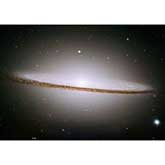Hats Off to the Sombrero
 This nearly edge-on view of the Sombrero galaxy shows that the disks of spiral galaxies are incredibly thin. The majestic spiral arms cannot be seen in this side view of the Sombrero, named because it resembles a broad-brimmed Mexican hat. But it does disclose many other interesting details that cannot be seen as clearly in a face-on picture. The photo reveals a swarm of stars in a pancake-shaped disk as well as a glowing central halo of stars. The disk displays dark dust lanes, where many young and bright stars reside. The Hubble telescope also shows that the glowing central bulge of stars harbors nearly 2,000 globular clusters of stars, 10 times as many as orbit our Milky Way galaxy.
This nearly edge-on view of the Sombrero galaxy shows that the disks of spiral galaxies are incredibly thin. The majestic spiral arms cannot be seen in this side view of the Sombrero, named because it resembles a broad-brimmed Mexican hat. But it does disclose many other interesting details that cannot be seen as clearly in a face-on picture. The photo reveals a swarm of stars in a pancake-shaped disk as well as a glowing central halo of stars. The disk displays dark dust lanes, where many young and bright stars reside. The Hubble telescope also shows that the glowing central bulge of stars harbors nearly 2,000 globular clusters of stars, 10 times as many as orbit our Milky Way galaxy.
The Hubble Heritage team of astronomers, who assemble many of the NASA Hubble Space Telescope's most stunning pictures, released this picture of the Sombrero to celebrate its five-year anniversary. Since its inception in 1998, the Hubble Heritage Project has released more than 65 images - one a month - of dazzling celestial objects, including planets, dying stars, regions of star formation, clusters of stars, individual galaxies, and even clusters of galaxies.
The Heritage team used Hubble's Advanced Camera for Surveys to take six pictures of the Sombrero and then stitched them together to create the final composite image. One of the largest Hubble mosaics ever assembled, this magnificent galaxy is nearly one-fifth the diameter of the full moon. The Sombrero resides on the southern edge of the rich Virgo cluster of galaxies and is one of the most massive objects in that group, equivalent to 800 billion suns. The galaxy is 50,000 light-years across and is located 28 million light-years from Earth.
Fact Credit
NASA Headquarters


